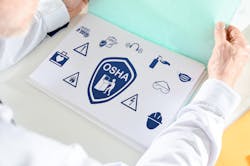According to a March 22 news release, the U.S. Department of Labor's Occupational Safety and Health Administration (OSHA) has partially reopened the rulemaking record and scheduled an informal public hearing for comments on the development of a final standard to protect healthcare and healthcare support service workers from exposure to COVID-19 in the workplace.
Comments can be submitted online, identified by Docket No. OSHA-2020-0004. Submit written comments by the deadline of April 22, 2022.
“Individuals interested in testifying at the hearing must submit their notice of intention to appear no later than 14 days after the publication of the Federal Register Notice,” the release adds. “The hearing will begin on April 27, 2022 and will take place online. If necessary, the hearing will continue on subsequent days. Learn more in the Federal Register notice.”
In June of 2021, OSHA issued an emergency temporary standard to protect workers in healthcare settings from occupational exposure to COVID-19.
We reported on Jan. 6 that labor organizations National Nurses United (NNU); AFL-CIO; American Federation of Teachers (AFT); American Federation of State, County, and Municipal Employees (AFSCME); as well as some of the nation’s other major nursing unions, including the New York State Nurses Association (NYSNA) and Pennsylvania Association of Nurses and Allied Professionals (PASNAP) petitioned the United States Court of Appeals for the District of Columbia Circuit to order the Department of Labor’s Occupational Safety and Health Administration (OSHA) to issue a permanent standard that requires employers to protect healthcare workers against COVID-19.
That said, “The agency is reopening the rulemaking record to allow for new data and comments on topics, including the following:
- Alignment with the Centers for Disease Control and Prevention's recommendations for healthcare infection control procedures.
- Additional flexibility for employers.
- Removal of scope exemptions.
- Tailoring controls to address interactions with people with suspected or confirmed COVID-19.
- Employer support for employees who wish to be vaccinated.
- Limited coverage of construction activities in healthcare settings.
- COVID-19 recordkeeping and reporting provisions.
- Triggering requirements based on community transmission levels.
- The potential evolution of SARS-CoV-2 into a second novel strain.
- The health effects and risk of COVID-19 since the ETS was issued.”
The news release concludes by saying that employers are required to continue to comply with their obligations under the General Duty Clause, Personal Protective Equipment and Respiratory Protection Standards, and other applicable OSHA standards.
More information about the issue and compliance assistance materials can be found here.


